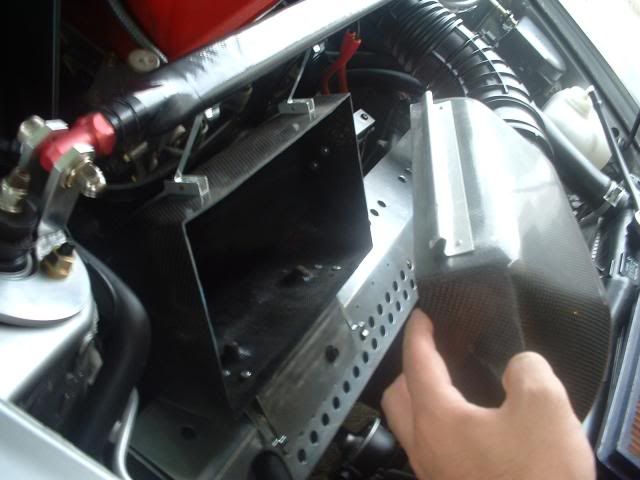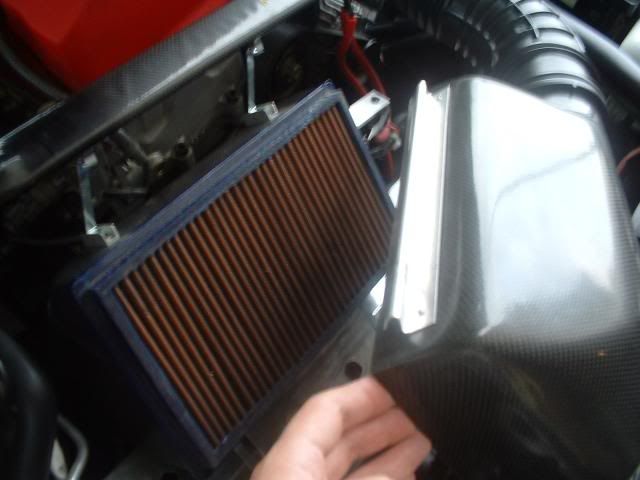sisi, el filtro de aire no es el problema (ademas ese filtro no se cambia, se limpia simplemente con chorro de agua.. ni aceite ni pollas) 
El problema es el filtro de aceite.. por debajo es ahora imposible de acceder (la trompa lo obstaculiza) y por arriba es posible pero "challenging" 
Solo pude probarlo en una ronda.. si hay mas rendimiento o no, no lo se (mi culo-dyno-error es de +-10HP y esto no da mas de 10HP) 
Voy a hacer luego pruebas de logeo de IAT, pero despues del tramo que hice, podia poner la mano en la admision durante minutos y no me quemaba.. con la caja de serie no hubiese aguantado ni 3 segundos (la jodida QUEMA despues de haberle metico canya al coche)
Uhm... perdón, me había parecido entender filtro de aire, no de aceite.
La chollo-web ésa que encontré ha actualizado el producto:
http://www.trt-shop....onda-s2000.htmlexc. VAT: 2195.04 LTL
inc. VAT: 2656.00 LTL
O sea:
exc. VAT: 625,86 €
inc. VAT: 757,29 €
Lo que comentaba del aire caliente proveniente del asfalto:
http://www.s2ki.com/...box-12-hp-more/As I recall the only reservations I have heard was a question of pulling air heated by the road (it is claimed that several feet are needed to find a cooler pool), but this is only a concern it areas with heavy solar gain.
Some of the question regarding location has to do with air temperature inches off the road. It may depend on your location, but in parts of the Southwestern US the solar gain is so high that a portion of the year the road itself is 110F - 140F. We commonly get temperatures over 100F and it is measured in the shade four feet above the ground, so I can imagine temps inches above the hot road maybe higher meaning that location for an air intake in those conditions can reduce power.
Y algunos comentarios de la gente:
The point about solar gain is a good one. Although underway at speed its less of a concern for me as overall airflow would probably make the temp differential between a standard CAI and this design pretty minimal - but I speculate.
We also don't know what the pressure picture looks like under the car in that location. For example, we know that the location of standard CAIs has probably at least atmospheric pressure. Its not in the best location possible because as the bumper slopes away from the flat center section pressures will drop in front. But if cut the inner divider you have access to high pressure air in front of the radiator.
For the underbody location, its tougher to say. Most cars have lift, which means the pressure under the car is higher than over the car. But this doesn't mean the pressure under the car is higher than atmospheric as lift is a relative thing. We do know that the area behind the radiator is designed to be a low pressure zone. But the intake is located behind the flat bottom front bumper panel. So what happens the airflow coming off of that? Does it slow down and increase pressure?
The short answer is, no one knows for sure if this is a good location for an intake. It would be useful to monitor temps in both this location and the fenderwell, as well as absolute air pressure in both - that's the only way to know which is more conducive to power. Until then we're theorizing.
UL
Made a few tests... Air temperature at the Mugen intake entrance was 1C above ambient regardless of speed. At a location close to the stock intake it was +10C at about 60km/h and, contrary to my expectation, went up to +14C when over 120km/h. As expected it was all over the roof when idling at a stop.
At a spot close to the tarmac (just below the driver's door) temperature was 5C above ambient regardless of speed. Don't know how this would translate to this CAI location, but could only go up being closer to major sources of heat. I didn't have the time or patience to hoist the car...
I used a barometer, but frankly could not detect any meaningful variations in static pressure in any of these locations. To evaluate changes in dynamic pressure I would need to use an anemometer, and I couldn't find anything suitable for the task.
Anyway, not really conclusive, but gives you a feel.
I have this intake on my car.
Trust the numbers,the car pulls like a freight train on the highway. I have been in a car with an aem, and there is no comparison , this intake is amazing at high speeds. Doesn't do much for lower speeds though although I have not seen a dyno, I really believe the numbers are right on.
oh and my car is slammed and I have driven in a huge downpour.
Don't give false information if you don't know the outcome. do you have any idea how much water it takes to suck straight up about 3 feet, past the filter and into the motor. If it ever gets this far (the water) it will vapourize from the heat anyways. Just drive normally in the rain , you will never have a problem.
And as far as the car being slammed, the lowest point of the intake, under the car is not lower then the factory chin oem spoiler , I measured. Not a problem again
this intake was designed great.
I have had this intake for over 2 years now (have 2 in stock as well) no problems with water being sucked up, as the AEM has a filter at the begginning of the intake that water is sucked into the filter as the MG Racing one has the filter at the top of the intake. It's hard to get a real dyno as the car has to be moving and air positioned at the bottom of the car, I had mine dyno'ed and there was 4 hp at the wheels but on the highway there is a big difference at high speeds where the wind is alot stronger.
Wouldn't the space between tarmac and underbody be a low pressure zone? Worse if you have a front spoiler. Inspite of what owners report I still find this design somewhat fishy....
Deibit, podrían sus "aparatos diabólicos" mostrar un aumento del aire (volumen y temperatura) que le llega al motor?


Editado por Storm, 27 June 2011 - 15:00:38.



















